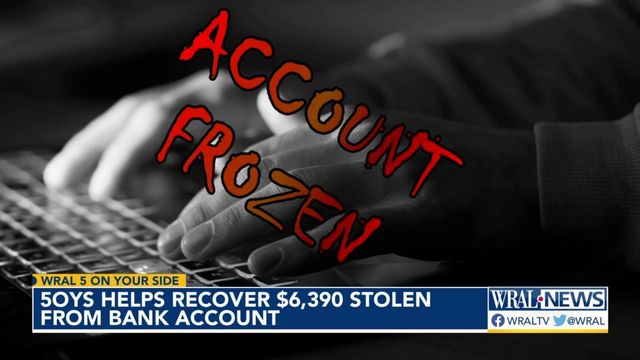Stymied by bank customer service, woman turns to 5 On Your Side to get money back after ID theft
Through a brutal mix of traditional and cyber-crime, a Raleigh woman lost every penny in her bank account. When she went to her bank for help, she says she got the run around until she contacted WRAL 5 On Your Side.
In October of 2022, Danielle Hahn went on a hike with her friend in Umstead Park. The park is located in Wake County and is mainly known for its calming beauty. Lately, however, it has gained another, more negative, reputation as a hot spot for purse theft. The problem is so persistent that park visitors are met with signs of Smokey Bear reminding them, "Only you can prevent purse theft."
On her way back from her hike, Hahn noticed her car window was down, but as she got closer to the car, she realized the window was bashed in and the purse that she had hidden in the back seat was gone. Hahn immediately notified her bank and had her credit cards and Wells Fargo debit card replaced.
The situation was upsetting, but resolved, or so she thought.
On Mar. 3, 2023, Hahn received a voicemail from a Wells Fargo branch in Virginia explaining that there was suspected fraud on her account. She was instructed her to go to her local branch. At her branch in Raleigh, she and the manager determined the voicemail was legitimate and that her account was indeed hacked.
Hahn tells WRAL 5 On Your Side that scammers likely impersonated her at a branch in Richmond, Va., using her stolen driver’s license. Cybersecurity expert Kobie Joyner serves as the department head of network and computer technologies at Wake Tech. He tells WRAL 5 On Your Side that it can be unnervingly easy for scammers to obtain a person’s bank account information if that is what they want.
“It doesn’t take much,” Joyner said. “You and I can take a note pad and say ‘Okay, maybe the password is this, maybe it’s that.’ But an algorithm on a password cracking software can do that thousands of times per second.”
The day her account was hacked Hahn tells WRAL 5 On Your Side that she was assured a hard freeze was put on her account, and that her account number would change, but it did not happen fast enough.
“Monday evening, I got a message saying my bank account had reached a zero balance,” Hahn said.
The scammers had taken out an additional $2,590, draining her account.
Hahn went on a phone-calling frenzy trying to get her money back. She called her bank's customer service in the Philippines and offices in the Midwest. She tells WRAL 5 On Your Side that she had to explain her story over and over again and a times felt like she was being questioned as the scammer.
“It was virtually impossible to navigate,” she said. “I was surprised by how I was made to feel like I was the criminal.”
At one point, her branch manager called on her behalf, and was redirected to customer service.
Then her husband contacted WRAL News, and 5 On Your Side got to work contacting the bank’s communication team in Charlotte. Within a few hours of explaining the situation, Hahn got a phone call that the missing $6,390 would go back into her account.
“It was pretty eye opening to know that when the bank came under some potential public fire, they were able to act pretty quickly,” Hahn said.
Under Regulation E, a federal law, a bank is responsible for lost funds when the money is stolen by a third party.
“Generally speaking, banks are required to reimburse customers for fraudulent transactions, assuming the customer did not participate in the crime and promptly reported it to the bank,” a spokesperson from the NC Attorney General’s office told 5 On Your Side in a statement.
When asked about the situation the Consumer Financial Protection Bureau echoed that advice.
“Reports and consumer complaints of payments scams have risen sharply, and financial fraud can be devastating for victims. The CFPB is working to prevent further harm, including by ensuring that financial institutions are living up to their investigation and error-resolution obligations.
“If someone believes they have been contacted by a scammer or if they have been the victim of a payments scam, they should report the scam to the Federal Trade Commission, or to their state Attorney General. Consumers may also submit a complaint with the CFPB online at consumerfinance.gov/complaint or by calling (855) 411-CFPB (2372).”
Wells Fargo would not comment on the matter directly, but offered this advice:
“We know identity theft is a stressful experience for victims, and we are pleased to resolve this issue for our customer. One instance of a fraudster using a stolen identity is one too many, so we are continually making improvements to our fraud prevention practices and procedures. We want to do everything we can to combat fraud, protect consumers and support fraud victims.”
How to prevent and mitigate identity theft
If you believe you are a victim of identity theft, report it to your bank right away.
Contact the credit bureaus to place a fraud alert or credit freeze on your credit report.
Notify your credit card companies, utility and phone providers and other financial institutions. Make sure that your personal information was not changed, and consider adding extra security features like a PIN, password, or voice verification.
Close any accounts that have been compromised and open new accounts with new passwords and PINs.
File a report with your local police. A police report provides proof of criminal activity which may help when contacting creditors to dispute charges or accounts opened in your name. Be sure to request a copy of the police report.
Consider taking additional steps to help protect yourself, such as:
Activate two-step verification on your accounts at sign-on for an additional layer of security.
Set up alerts to help track your transactions and spot unusual activity.
Make sure your contact information is up to date so your bank or financial institution can contact you if they see unusual activity on your accounts.
To help people quickly identify fraud and scams, Wells Fargo has a number of resources available online including an Identity Theft Assistance Kit.
Here are three steps to protect yourself against identity fraud from AARP
1-Place a security freeze on your credit accounts with the three main credit bureaus so no one can open a new credit line in your name.
2- Establish online access to your financial accounts and monitor them regularly. You can typically set up text alerts for activity on these accounts.
3- Use unique passwords for every online account; consider purchasing a password manager that creates complex passwords and stores them securely.











